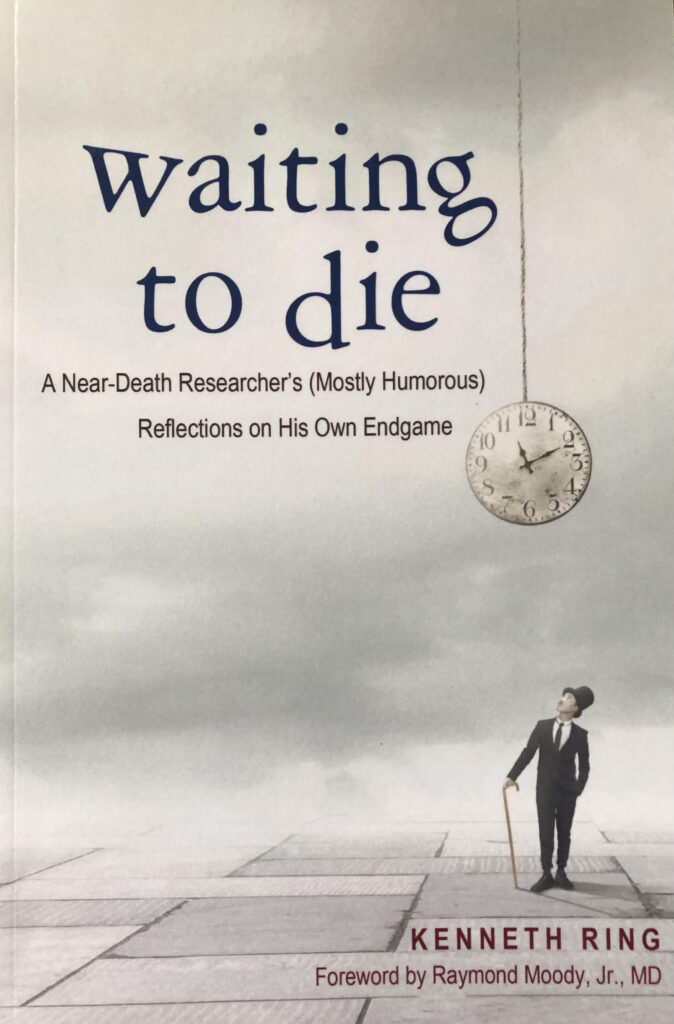
Tucson, Wheatmark, 2019 ISBN: 978-1-62787-698-8. Paperback: 137 pp.
In the beginning was Raymond Moody: near-death researcher, coiner of the term ‘Near-Death Experience’, and writer of the 1975 multi-million copy bestseller Life After Life which effectively defined what a Near-Death Experience (NDE) was for fellow NDE research ‘pioneers.’ Foremost amongst these was Kenneth Ring who was amongst the first to confirm many of Moody’s ground-breaking findings whilst exploring many hitherto unexamined aspects of the phenomenon including its effects on the lives of experiencers and its similarity to other ‘anomalous’ events such as those undergone by UFO abductees.
The author’s bravery in treading where few if any had dared to tread before him is evident in Waiting To Die, a collection of mostly humorous essays in which he faces up to the inevitability of death. I should stress here that at the time of writing – both of Waiting To Die and this review of it – Kenneth Ring was and is very much in the land of the living; indeed, his reaction to a premature announcement of his own demise is explored in a couple of the later essays.
Readers approaching Waiting To Die in the hope of discovering anything ‘new’ about NDEs may well be disappointed because there’s nothing really new here. Instead, the author treats us to many of his own past research findings, but filtered through a series of reflections on his – and everybody else’s – own inevitable demise. There are various take-aways from this. Hence, for example, he uses extracts from NDEs to challenge the view of ‘that contemporary clutch of infamous atheists’ such as Richard Dawkins, Daniel Dennett, Christopher Hitchens and Sam Harris that death is a ‘dead end.’ He also cites evidence that treating those at the end of their own life journeys with psychedelics such as ketamine and psilocybin – which in some ways mimic the effects of NDEs – might be beneficial in reducing their fears of death. Indeed, this is one of the aspects of near-death research that will forever after be associated with Ring: his finding in his 1984 book Heading Toward Omega that NDEs bring positive life-enhancements in their wake, including a radically diminished fear of death. That we may be offered ‘Better Dying Through Chemistry’ – to quote the title of the relevant essay in this collection – is in a sense a natural extension of this, as is the suggestion he gives to author Julian Barnes in another essay (‘Nothing To Be Frightened Of’) that simply reading the literature on NDEs might be used ‘to conquer the fear of death.’
These selected highlights might give the impression that Waiting To Die is mainly NDE-based but this is not really the case. Whilst the author’s NDE research is a recurring theme, the book’s chief focus remains throughout as a series of existential reflections on ageing and everything that goes with that. This is done with humour and charm, making Waiting To Die an engaging, if sometimes melancholy, collection. It is to the writer’s credit, though, that the melancholy is never overdone, resulting in a read both upbeat and inspiring.
I corresponded with Ken Ring briefly some years ago when I was writing my own book on NDEs. He had just co-written a study which made the startling claim that congenitally blind people had been able to see for the first and only time in their lives during the out-of-body phases of their own Near-Death Experiences: a claim reiterated in Waiting To Die. I challenged the quality of both the evidence and the science (and the philosophy) underlying this and we agreed to disagree. Nonetheless, the hope offered by NDEs that physical decline will not continue in perpetuity is another of the essay collection’s themes and adds to its generally hopeful tone. I read it in a sitting and enjoyed it thoroughly. Is it too much to hope for a sequel?
This review first appeared in The Christian Parapsychologist, New Series Vol 3 No 1 pp. 45 – 7.